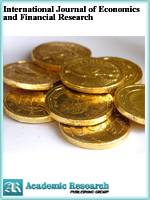International Journal of Economics and Financial Research
Online ISSN: 2411-9407
Print ISSN: 2413-8533
Print ISSN: 2413-8533
Quarterly Published (4 Issues Per Year)

Archives
Volume 2 Number 5 May 2016
Testing the Existence of Lead-Lag Effects in the Hong-Kong Stock Market
Authors: Latifa Fatnassi Chaibi
Pages: 99-103
Abstract
The aim of this paper is to investigate the lead-lag effect between two indices on the HONG-KONG stock market. This analysis is applied to daily data from 14/04/2003 to 10/10/2014. The results show that the more liquid index leads the less liquid. These results are consistent with those shown by the impulse response function. These results concluded that the predictability of less liquid index by more liquid index returns. In these studies, we can conclude that the lead-lag effect can generate a predictability of returns of the two indices of Hong-Kong stock exchange in the case of daily data.
Non-Maturity Deposit Modeling in the Framework of Asset Liability Management
Authors: Sa?d Benbachir ; Mohammed Mehdi El Hamzi
Pages: 79-98
Abstract
Liquidity risk is one of the major risks inherent in the banking business. It occurs when the bank does not have sufficient liquid assets to meet its commitments at the time of their occurrence. The most critical challenges confronting financial institutions when managing liquidity risk is so-called non-maturity accounts. These accounts are characterized by the fact that they have no specific contractual maturity, and their risk management is complicated by the embedded options that depositors may exercise. As part of an asset-liability management and for the purpose of healthy and prudential management of a liquidity risk, each bank must properly assess the deposits of its customers. Liquidity risk is not the risk that there are massive withdrawals, but the risk they are unanticipated. In this paper, we apply two methods to model non-maturity deposits of a Moroccan commercial bank. We treat separately individual deposits and enterprise deposits aiming an accurate analysis. We then select between the models by means of a selection criteria. Furthermore, we back-test and forecast future deposits using the selected model. Finally, we model the decay rates of non-maturity deposits by elaborating a flowing function of these latter.



